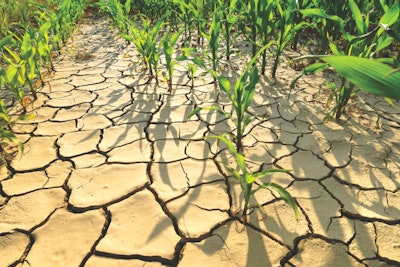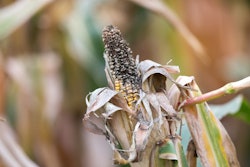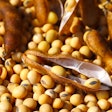
A look at how feed additives and other new technologies will be used to mitigate mycotoxin risks
Climate change is a major concern worldwide — making headlines and mobilizing the world’s leaders to take action.
For example, the United Nations Framework Convention on Climate Change’s (UNFCCC) Paris Agreement aims to lead the global response against the threat of climate change by keeping a global temperature increase “below 2 degrees Celsius above pre-industrial levels and to pursue efforts to limit the temperature increase even further to 1.5 degrees Celsius.” The agreement has been ratified or acceded by 185 states and the EU, representing more than 88% of total global greenhouse gas emissions.
As the climate system has shifted due to warmer temperatures, new weather patterns have emerged produced serious challenges for all facets of agriculture. Around the world, weather and temperatures no longer follow predictable patterns.
Farmers struggle with climate extremes — both drought and wet conditions — that impact crop production, leading to inconsistent growing seasons, crop quality and yields.
For example, according to Neogen’s most recent Monday Mycotoxin report, U.S. corn maturity is behind its five-year average, with reports of low grain quality in key states. Spring 2019 planting was delayed due to excessively wet conditions, and the late harvest runs the risk of making crops more susceptible to mold growth.
“The correlation of extreme weather conditions and the production of various toxins is well documented,” says Pat Frasco, Neogen’s director of corporate accounts for milling and grain. “If current trends continue, producers can expect to continue seeing higher levels of mycotoxins.”
Mycotoxins, the secondary chemical metabolites produced by fungi, contaminate crops, including grains and forages, and result in negative health effects in humans and animals.
“Mycotoxin formation by fungi is highly influenced by climatic conditions, such as temperature, precipitation and humidity,” explains Dr. Alexandra Weaver, global technical support, Alltech Mycotoxin Management. “Environmental warming, greater precipitation or drought, and increasing concentrations of gasses such as carbon dioxide may impact mycotoxin production by mycotoxigenic fungi.”
Increasing prevalence of mycotoxins
There has been an increase in mycotoxin contamination in crops worldwide. According to Biomin’s September 2019 PROcheck mycotoxin survey, 97% of its 2018 U.S. corn sample pool tested positive for at least one mycotoxin; meanwhile, co-contamination was found in 75% of its samples from around the world.
Modeling research shows increasing incidents and potential modifications in global mycotoxin contamination scenarios.
Fumonisins and aflatoxins thrive in drought conditions.
“This will have a true impact, especially on the developing countries such as Africa, Southeast Asia, but also southern parts of Europe where increasing periods of drought and weather extreme conditions are becoming more prevalent,” notes Pedro Caramona, global program manager – mycotoxin risk management, Trouw Nutrition.
In cooler and wetter conditions, there will be more deoxynivalenol (DON), trichothecenes (T-2/HT-2) and zearalenone (ZEN).
In addition to an increase in mycotoxin contamination and co-contamination, producers will continue to see new mycotoxins appearing in regions where they are not commonly found today. For instance, Northern Europe could see aflatoxins contaminations where historically have not occurred.
 Climate change creates the perfect conditions for mold and, therefore, more mycotoxins. For example, drought conditions produce increased levels of fumonisins and aflatoxins. (Misha Kaminsky | iStock.com)
Climate change creates the perfect conditions for mold and, therefore, more mycotoxins. For example, drought conditions produce increased levels of fumonisins and aflatoxins. (Misha Kaminsky | iStock.com)Mycotoxins harm poultry, livestock
Not only are poultry and livestock producers required to address the production challenges of unfavorable environmental conditions, e.g. heat stress, but mycotoxin risks add another layer of complexity as they can impact animal health and result in chronic conditions that reduce productivity, fertility, feed intake and efficiency.
“The feed industry will definitely have to adapt to the challenges [of climate change],” says Julia Laurain, feed specialist, Olmix Group. “Animals will be exposed to new feed challenges, such as materials with lower digestibility, new anti-nutritional factors and an increase in contaminants.”
Producer awareness, risk identification and education are part of a strong mycotoxin risk management strategy, and feed producers play a vital role in this effort.
Beyond assisting in the creation of risk management programs, what tools are animal feed producers using to mitigate the effects of mycotoxin contamination?
Tools for combating mycotoxins in feed
Every year, many new technologies and innovations are being developed and introduced to the animal feed and related industries to identify and combat mycotoxins. Here are a few of the front-line tools used to mitigate mycotoxin risks.
Monitoring technology: Data collection and evaluation are critical to better understand the prevalence of mycotoxins and estimate the related risks.
“A correct mycotoxin risk assessment is crucial to implement the right mycotoxin mitigation strategy at the right time, right place and right amount,” says Mike Johnson, director of strategic marketing & portfolio for Cargill Health Technologies.
A variety of diagnostic tools can provide an analytical assessment of raw materials and identify the types of mycotoxins present and their concentration.
“Some of these tools may be utilized directly on-farm or at the feed mill to provide a real-time picture of contamination by a certain mycotoxin in a feedstuff,” Weaver explains. “More advanced techniques can also be used to gain insight on multi-contamination by numerous mycotoxins in a feedstuff or a complete ration.”
Analyzing grain and feed samples for a broad range of mycotoxins allows producers to determine the degree of the mycotoxin challenge and implement an effective mitigation strategy.
Meanwhile, several vendors offer feed producers access to global mycotoxin contamination data to assist in predicting future risk levels of feeds and raw materials.
“Knowing the quality of the feed ingredients is very important — you need to measure it before you can manage it,” Frasco says.
Animal health management: A healthy animal will better cope with mycotoxins’ effect on gut integrity, its immune system, oxidative stress and several other health parameters, Johnson notes, adding that technologies to support protection and detoxification will continue to emerge as mycotoxin risk evolves.
However, the recommendation bleeds over into promoting better farm management practices. For example, as the use of antibiotics decreases, ensuring the health status of the herd becomes increasingly important.
“As mycotoxins have a marked effect on the immune system, largely evident in young and high-performing animals, placing further attention on farm management and nutritional strategies to reinforce intestinal health and immune competence need to be considered, to minimize the impact of mycotoxins on animal health and productivity, particularly when antibiotic use is reduced or replaced as a target,” Caramona says.
Feed additives: The use of feed additives to manage mycotoxins within the animal is another important component of a mycotoxin management program. While many feed additive products exist to mitigate the health effects of mycotoxins, binders are a proven technology to render a variety of mycotoxins chemically inactive.
“However, not all binders are created equal and particular attention should be paid to in vivo results,” says Johnson.“In vitro results can be misleading as it is difficult to replicate real-life conditions experienced on the farm.”
Weaver recommends yeast cell wall-based materials, shown to adsorb mycotoxins within the gastrointestinal tract and reduce their negative impacts, and the addition of effective multi-mycotoxin mitigators.
Laurin also suggests the preventive use of gut health enhancers.
While the long-term influence climate change has on global crop production and quality is uncertain, animal feed producers have the diagnostic, data and feed additive technologies for ensuring the production of safe, nutritious feed.
5 mycotoxin risk factors
Triggered by changing environmental conditions, Alltech Mycotoxin Management’s global director, Nick Adams, notes several factors contributing to increased mycotoxin risks:
- Stress: Molds often produce mycotoxins during periods of stress, i.e. climate, chemical or competitor triggers. With increased temperatures, altered moisture levels or high carbon dioxide levels, molds may become more stressed, leading to additional mycotoxin production.
- Adaptability: Molds are resilient and can evolve rapidly, causing them to be better equipped than grain and forage crops in coping with changing conditions.
- New mycotoxins: As molds adapt to changing conditions, there is potential for them to produce more mycotoxins, switch from one to another or even begin to produce completely new mycotoxins. If new mycotoxins are produced by molds that are as of yet undetected, producers may be in the dark on what is causing a challenge in their animal.
- New distribution patterns: With changes in climatic conditions throughout the world, molds may be on the move. With an increase in global temperatures, northern climates that rarely saw risk from mycotoxins, such as aflatoxins or fumonisins, may now find these as common occurrences.
- Grain handling: As extreme weather events become more common, producers may have increased difficulty in properly storing crops and feed. During storage conditions, molds may continue to thrive and produce mycotoxins.















